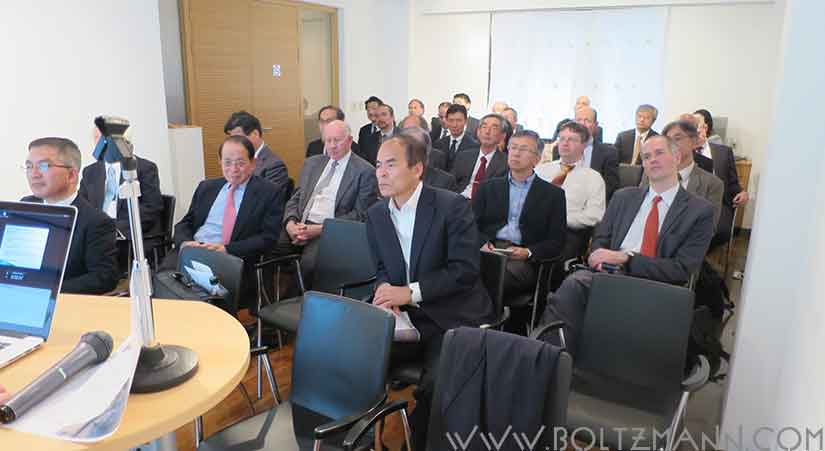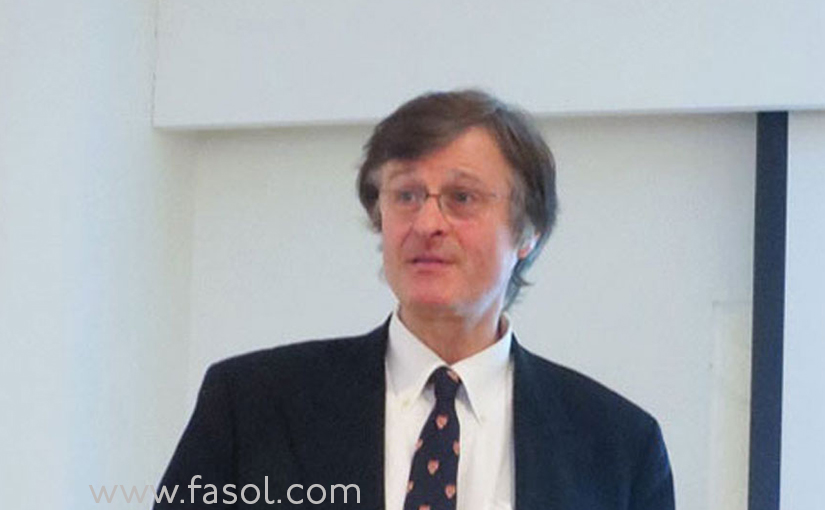Ludwig Boltzmann – the revolutionary, Boltzmann’s work, Boltzmann’s constant and entropy
Gerhard Fasol
keynote talk given at the 7th Ludwig Boltzmann Forum at the Embassy of Austria, Tokyo, 20 February 2015

by Gerhard Fasol, Physicist, opto-electronics and spin-electronics. CEO, Eurotechnology Japan KK. Board Director of GMO Cloud KK. Served on the Faculty of Tokyo University, Cambrige University, and Trinity College, Cambridge.
Boltzmann constant k, the definition of the unit of temperature and energy
Temperature is one of the physics quantities we use most, and understanding all aspects of temperature is at the core of Ludwig Boltzmann’s work. People measured temperature long before anyone knew what temperature really is: temperature is a measurement of the average kinetic energy of the atoms of a substance. When we touch a body to “feel” its temperature, what we are really doing is to measure the “buzz”, the thermal vibrations of the atoms making up that body.
Boltzmann worked out the distribution of energy, thermal vibrations of atoms in a solid, thermal kinetic energy of atoms or molecules in a gas, or the thermal energy in more complex classical systems is distributed as a function of temperature in the case of equilibrium. Boltzmann has also worked on systems in transition, and has developed powerful mathematical tools, the Boltzmann Equations, to understand systems in transitions or flow.
For an ideal gas, the kinetic energy per molecule is equal to 3/2 k.T, where k is Boltzmann’s constant. Generalized, the energy is 1/2 k.T per degree of freedom. Therefore Boltzmann’s constant directly links energy and Temperature.
However, when we measure “Temperature” in real life, we are not really measuring the true thermodynamic temperature, what we are really measuring is T90, a temperature scale ITS-90 defined in 1990, which is anchored by the definition of temperature units in the System International, the SI system of defining a set of fundamental physical units. Our base units are of fundamental importance for example to transfer semiconductor production processes around the world. For example, when a semiconductor production process requires a temperature of 769.3 Kelvin or mass of 1.0000 Kilogram, then accurate definition and methods of measurement are necessary to achieve precisely the same temperature or mass in different laboratories or factories around the world.
The SI system of physical units is switching to a new fundament
Read about the new SI system of physical units in more detail here.
Each fundamental constant Q is a product of a number {Q} and a base unit [Q]:
Q = {Q} x [Q],
for example Boltzmann’s constant is:
k = 1.380650 x 10-23 JK-1.
Thus we have two ways to define the SI system of SI base units:
- we can fix the units [Q], and then measure the numerical values {Q} of fundamental constants in terms of these units (method valid today to define the SI system)
- we can fix the numbers {Q} of fundamental constants, and then define the units [Q] thus that the fundamental constants have the numerical values {Q} (future method of defining the SI system)
Over the next few years the SI system of units will be switched from the today’s method (1.) where units are fixed and numerical values of fundamental constants are “variable”, i.e. determined experimentally, to the new method (2.) where the numerical values of the set of fundamental constants is fixed, and the units are defined such, that their definition results in the fixed numerical values of the set of fundamental constants. This switch to a new definition of the SI system requires international agreements, and decisions by international organizations, and this process is expected to be completed by 2018.
Today’s method (1.) above is problematic: The SI unit of temperature, Kelvin is defined as the fraction 1/273.16 of the thermodynamic temperature at the triple point of water. The problem is that the triple point depends on many factors including pressure, and the precise composition of water, in terms of isotopes and impurities. In the current definition the water to be used is determined as “VSNOW” = Vienna Standard Mean Ocean Water. Of course this is highly problematic, and the new method (2.) will not depend on VSNOW any longer.
In the new system (2.) the Kelvin will be defined as:
Kelvin is defined such, that the numerical value of the Boltzmann constant k is equal to exactly 1.380650 x 10-23 JK-1.
Measurement of the Boltzmann constant k:
Read about Boltzmann’s constant k in more detail here.
In order to link the soon to be fixed numerical value of Boltzmann’s constant to currently valid definitions of the Kelvin, and in particular to determine the precision and errors, it is necessary to measure the value of Boltzmann’s current in terms of today’s units as accurately as possible, and also to understand and estimate all errors in the measurement. Several measurements of Boltzmann’s constants are being performed in laboratories around the world, particularly at several European and US laboratories. Arguably today’s best measurement has been performed by Dr Michael de Podesta MBE CPhys MInstP, Principal Research Scientist at the National Physical Laboratory NPL in Teddington, UK, who has kindly discussed his measurements and today’s status of the work on the system of SI units and its redefinition with me, and has greatly assisted in the preparation of this article. Dr Podesta’s measurements of Boltzmann’s constant have been published in:
Michael de Podesta et al. “A low-uncertainty measurement of the Boltzmann constant”, Metrologia 50 (2013) 354-376.
Dr Podesta’s measurements are extremely sophisticated, needed many years of work, and cooperations with several other laboratories. Dr. Podesta and collaborators constructed a highly precise resonant cavity filled with Argon gas. Dr. Podesta measured both the microwave resonance modes of the cavity to determine the precise radius and geometry, and determined the speed of sound in the Argon gas from acoustic resonance modes. Dr Podesta performed exceptionally accurate measurements of the speed of sound in this cavity, which can be said to be the most accurate thermometer globally today. The speed of sound can be directly related to 3/2 k.T, the mean molecular kinetic energy of the Argon molecules. In these measurements, Dr. Podesta very carefully considered many different types of influences on his measurements, such as surface gas layers, shape of microwave and acoustic sources and sensors etc. He achieved a relative standard uncertainty of 0.71. 10-6, which means that his measurements of Boltzmann’s constant are estimated to be accurate to within better than on millionth. Dr. Podesta’s measurements directly influences the precision with which we measure temperature in the new system of units.
Over the last 10 years there is intense effort in Europe and the USA to build rebuild the SI unit system. In particular NIST (USA), NPL (UK), several French institutions and Italian institutions, as well as the German PTB (Physikalische Technische Bundesanstalt) are undertaking this effort. To my knowledge there is only very small or no contribution from Japan to this effort, which was surprising for me.
What is today’s best value for the Boltzmann constant k:
Today’s accepted best value of Boltzmann’s constant is the “2010 Codata value”:
k = 1.380 6488 . 10-23 JK-1, and the standard uncertainty is:
su = 0.000 0013 . 10-23 JK-1
Ludwig Boltzmann – the leader
Ludwig Boltzmann was not only a monumental scientist, but also an exceptional leader, teacher, educator and promoter of exceptional talent, and he promoted many women.
One of the women Ludwig Boltzmann promoted was Henriette von Aigentler, who was refused permission to unofficially audit lectures at Graz University. Ludwig Boltzmann advised and helped her to appeal this decision, in 1874, Henriette von Aigentler passed her exams as a high-school teacher, and on July 17, 1876, Ludwig Boltzmann married Henriette von Aigentler, my great-grand mother.
Another woman Ludwig Boltzmann promoted was his student Lise Meitner (Nov 1878 – Oct 27, 1968), who later was part of the team that discovered nuclear fission, work for which Otto Hahn was awarded the Nobel Prize. Lise Meitner was also the second woman to earn a Doctorate degree in Physics from the University of Vienna. Element 109, Meitnerium, is named after Lise Meitner.
Ludwig Boltzmann – the scientist
Ludwig Boltzmann’s greatest contribution to science is that he linked the macroscopic definition of Entropy which came from optimizing steam engines at the source of the first industrial revolution to the microscopic motion of atoms or molecules in gases, this achievement is summarized by the equation S = k log W, linking entropy S with the probability W. k is the Boltzmann constant, one of the most important constants in nature, linked directly to temperature in the SI system of physical units. This monumental work is maybe Boltzmann’s most important creation but by far not the only one. He discovered many laws, and created many mathematical tools, for example Boltzmann’s Equations, which are used today as tools for numerical simulations of gas flow for the construction of jet engines, airplanes, automobiles, in semiconductor physics, information technology and many other areas. Although independently discovered, Shannon’s theory of noise in communication networks, and Shannon’s entropy in IT is also directly related to Boltzmann’s entropy work.

Copyright (c) 2015 Eurotechnology Japan KK All Rights Reserved

Leave a Reply